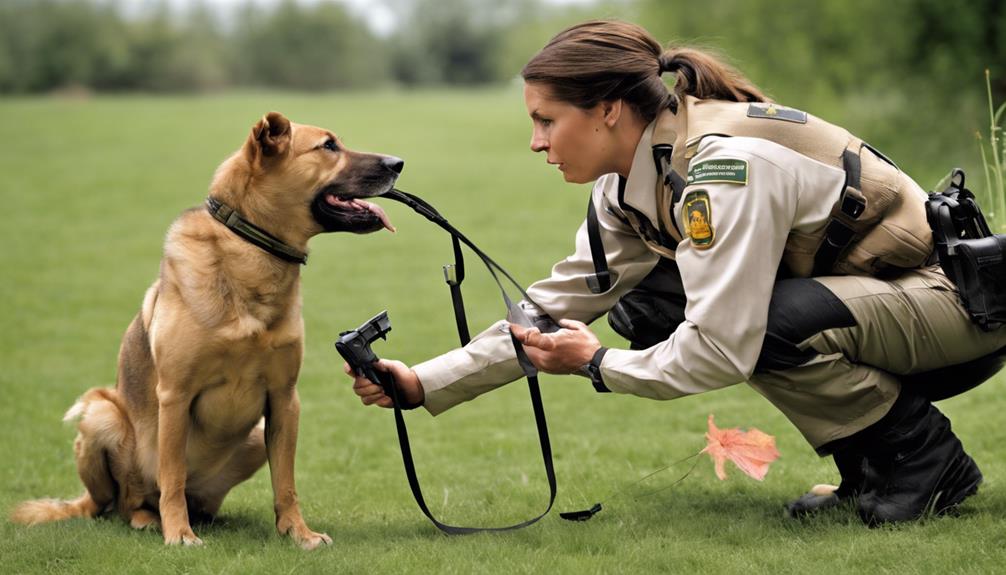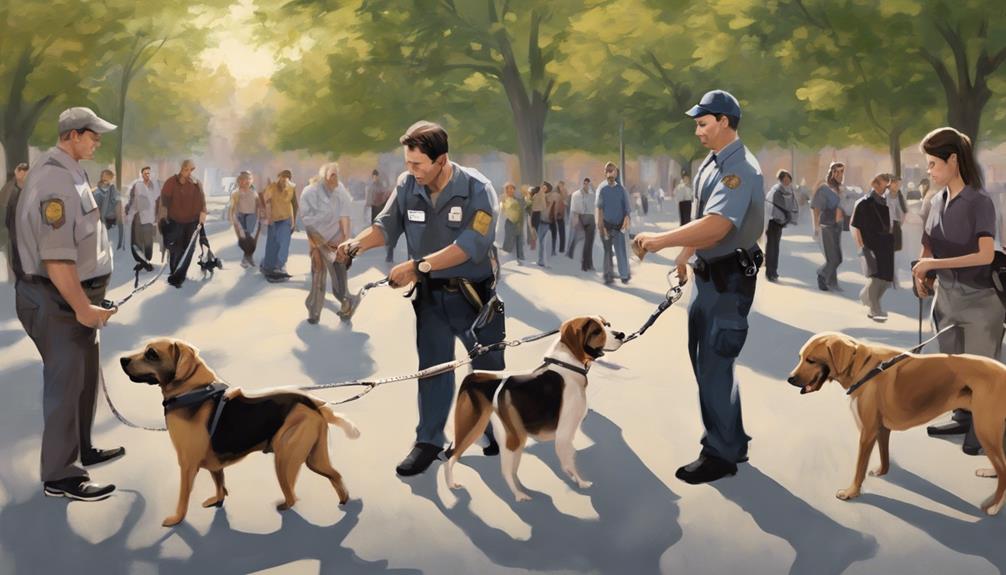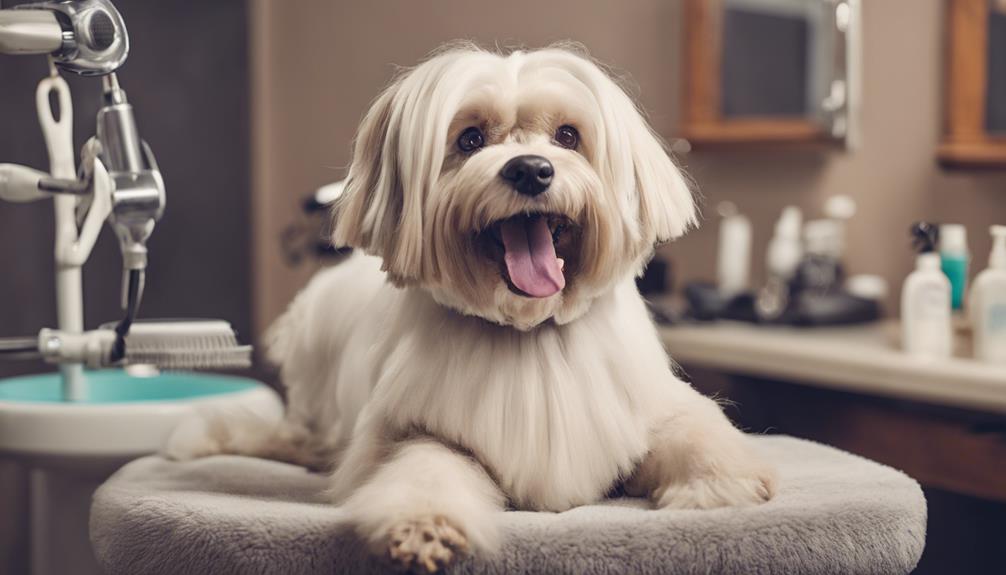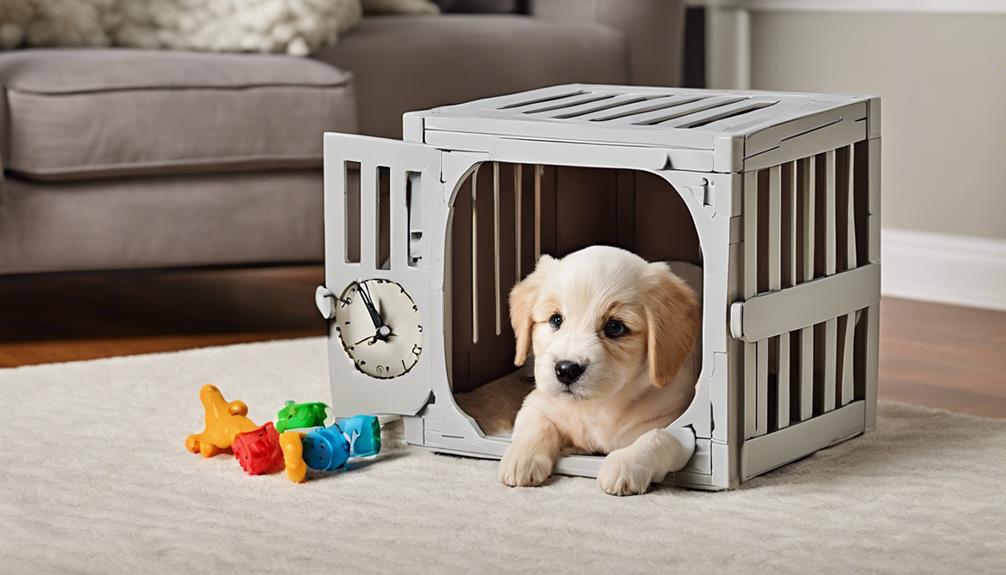As professional dog handlers, our success is dependent on mastering a diverse range of skills that are essential for the care and training of our canine partners. This includes interpreting dog body language, understanding canine behavior, and developing a strong work ethic. Additionally, we must understand theoretical training principles, improve our report writing skills, have a grasp of ecology backgrounds, appreciate canine olfaction abilities, and master various dog training techniques. These foundational abilities are crucial for ensuring the overall well-being, effective training, and successful handling of dogs.
Key Takeaways
- Dog body language interpretation is crucial for assessing emotions and behaviors accurately.
- Understanding canine behavior cues helps in socialization and adjusting training approaches effectively.
- Developing a strong work ethic is essential for punctuality, consistency, and professionalism in care.
- Mastery of dog training techniques like positive reinforcement and clear commands is vital for success.
- Report writing skills are important for accurately documenting incidents and maintaining professionalism.
Dog Body Language Interpretation
Understanding dog body language is essential for dog handlers to effectively communicate and interact with dogs in various situations. Dog body language interpretation involves keen observation of their posture, facial expressions, and tail movements to discern their mood and intentions accurately.
When a dog displays a relaxed body, wagging tail, and soft eyes, it typically signifies a friendly or playful demeanor. Conversely, signs of aggressive body language such as raised hackles, stiff posture, growling, or bared teeth indicate potential danger and the need for caution.
To truly grasp a dog's emotional state and level of comfort, one must pay close attention to their ears, eyes, and overall body tension. By carefully analyzing these cues, dog handlers can adapt their approach accordingly to foster a positive and safe interaction. Mastering the art of reading and responding to subtle nuances in a dog's body language is pivotal for successful communication and building a strong bond with our canine companions.
Canine Behavior Understanding

Understanding canine behavior is fundamental in our role as dog handlers. By recognizing body language cues and socialization techniques, we can effectively communicate and respond to our canine partners' needs.
This knowledge forms the basis for building trust, establishing rapport, and creating a strong bond with the dogs we work with.
Body Language Cues
When observing dogs, we can discern their emotions and intentions through subtle body language cues. Understanding canine body language is essential for effective communication during training and handling tasks. By learning to interpret cues like tail wagging, ear positioning, and eye contact, handlers can gauge a dog's emotional state and intentions accurately.
Recognizing signs of stress, fear, excitement, or aggression through body language enables handlers to adjust their approach appropriately. Being observant and responsive to a dog's body language helps create a positive interaction. Training in reading canine body language not only enhances handling skills but also strengthens the bond between handlers and dogs, leading to more successful outcomes in various situations.
Socialization Techniques
To effectively socialize dogs and understand their behavior, we employ techniques that focus on fostering positive interactions and building confidence in our canine companions. Understanding dog behavior and recognizing canine body language cues are essential in evaluating their comfort level during socialization.
By gradually exposing dogs to new environments and experiences, we can help them overcome behavioral issues and promote positive interactions with others. Important reinforcement plays a vital role in reinforcing desirable social behaviors, making the training process more effective and enjoyable for both the dog and the handler.
Through patience, knowledge, and a compassionate approach to dog training, we can create well-adjusted and confident companions who thrive in various social settings.
Work Ethic Development
As canine handlers, we appreciate the significance of punctuality in our handling duties; being reliable and on time sets the tone for successful interactions with our canine companions.
Responsibility and dedication are key pillars of our work ethic, guiding us to consistently provide the best care and training for the dogs in our charge.
Professionalism in our interactions not only fosters trust between us and our canine partners but also sets a standard for excellence within the dog handling community.
Punctuality in Handling
Maintaining punctuality in handling is essential for establishing a structured routine that nurtures trust and reliability between dog handlers and their canine companions.
- Consistent Feeding: Timely meals create predictability for dogs.
- Regular Walking: Scheduled walks help dogs anticipate exercise and bathroom breaks.
- Prompt Training Sessions: Punctuality in training reinforces discipline and expectations.
- Structured Work Routine: Establishing a daily schedule builds a sense of security and stability for the dogs.
Being punctual in all aspects of dog handling demonstrates professionalism and dedication. It sets a positive example for the dogs, showing them what to expect and when to expect it. By prioritizing timeliness, handlers create a harmonious environment that supports the well-being and progress of their canine companions.
Responsibility and Dedication
Responsibility and dedication form the cornerstone of a strong work ethic essential for success in the field of dog handling. As handlers, our commitment to the well-being and safety of the dogs under our care is paramount. Demonstrating reliability and accountability in every task fosters trust and strengthens our partnership with the animals.
Upholding high standards of care and professionalism not only reflects our dedication but also guarantees the dogs receive the best possible treatment. Responsibility and dedication aren't just traits; they're the pillars that support effective training, clear communication, and overall success in our role as dog handlers. By embodying these qualities, we can cultivate a work ethic that elevates our skills and enriches our bond with the dogs we work with every day.
Professionalism in Interactions
Building a reputation of professionalism in interactions as a dog handler involves embodying values such as punctuality, reliability, and respect towards clients and colleagues. As Basic Handlers, our work ethic and professionalism are essential for success. Here are key aspects to take into account:
- Punctuality: Arriving on time shows respect for others' schedules.
- Reliability: Being consistent and dependable builds trust with clients and colleagues.
- Respect: Treating everyone with courtesy and consideration fosters positive relationships.
- Integrity: Upholding ethical standards and being honest in all interactions solidifies our professional reputation.
Theoretical Training Principles Grasp

Understanding the core theoretical training principles is crucial for all dog handlers aiming to establish effective communication and training techniques with their canine companions. Mastery of theoretical concepts such as operant conditioning and positive reinforcement is vital to achieving successful training outcomes. By delving into the intricacies of canine behavior and learning theories, handlers can tailor their training methods to suit the individual needs of each dog. This knowledge not only aids in building a strong bond and trust between the handler and the dog but also paves the way for continuous learning and application of these principles to enhance training skills. As handlers, we recognize the importance of staying informed and evolving our techniques to guarantee the best possible outcomes for our furry partners. Below is a table summarizing the essential theoretical training principles every handler should grasp:
| Training Principles | Theoretical Concepts | Application |
|---|---|---|
| Operant Conditioning | Positive Reinforcement | Canine Behavior |
| Learning Theories | Building a Strong Bond | Trust |
| Continuous Learning | Application |
Report Writing Skills

Developing proficient report writing skills is a fundamental aspect of effective communication and documentation within dog handling operations. When it comes to report writing skills in dog handling and training, there are several key points to contemplate:
- Accuracy and Detail: Reports should precisely document incidents, activities, and observations to maintain precise records.
- Communication and Teamwork: Properly written reports assist in effective communication within the team and with higher authorities.
- Legal Significance: Handler's report writing skills can be pivotal in legal proceedings, investigations, and disciplinary actions.
- Professionalism: Training in report writing guarantees that handlers can convey information clearly, concisely, and professionally.
Mastering report writing is essential for professionalism in dog handling operations, especially in contexts where reports may be utilized in legal proceedings or investigations. By honing these skills, handlers can make sure that their documentation is clear, thorough, and contributes to the overall success of their operations.
Ecology Background Understanding

How can a strong ecological background benefit wildlife detection dog handlers? Understanding ecological principles is essential for handlers as it directly impacts the success of detection dog teams in the field. Adept knowledge of target species' behaviors and habitats allows handlers to interpret dog behaviors and indications accurately, leading to more effective searches. Lack of ecological understanding can hinder field success by impeding the selection of appropriate search areas and optimizing the performance of detection dogs. By incorporating ecological principles into training and operations, handlers can greatly enhance their team's effectiveness.
| Ecology Background Understanding | ||
|---|---|---|
| Benefits | Key Aspects | Impact |
| Enhances indication interpretation | Knowledge of target species behaviors | Improved search efficiency |
| Facilitates selection of search areas | Understanding habitats | Better field success rates |
| Optimizes dog performance | Applying ecological principles | Increased detection accuracy |
Canine Olfaction Comprehension

With an impressive sense of smell that surpasses human capabilities by thousands, dogs possess a remarkable olfactory ability essential for various detection tasks. Understanding canine olfaction is key for handlers to maximize their dog's potential in scent analysis and detection work.
- Canine olfaction is the sense of smell in dogs, which is incredibly more sensitive than that of humans.
- Dogs have about 300 million olfactory receptors in their noses, which is notably more than the 5-6 million in humans.
- Dogs can differentiate between individual scents within a complex odor, making them valuable in detection work such as narcotics, explosives, and search and rescue operations.
- The olfactory bulb in a dog's brain is larger than that in humans, allowing them to process and analyze scents more effectively for various tasks.
Dog Training Techniques Mastery

To master dog training techniques effectively, one must prioritize the mastery of positive reinforcement and clicker training methods. Understanding operant conditioning and reward systems is vital in shaping desired behaviors in our canine companions.
Proficiency in issuing clear voice commands and maintaining consistency throughout training sessions are key components of successful dog training. By recognizing and interpreting behavioral signals exhibited by dogs, we can tailor our training methods to suit their individual needs, fostering a deeper understanding and connection.
Developing patience and persistence during training sessions not only aids in achieving training goals but also helps in building a strong bond and trust with our furry friends. With dedication to mastering these techniques and a compassionate approach, we can create a harmonious training environment that nurtures both the dog's well-being and our relationship with them.
Frequently Asked Questions
What Skills Are Needed for Dog Handling?
We grasp the importance of dog handling skills. Recognizing behavioral cues, grooming knowledge, patience, and breed education are key. Our team values continuous learning and aims to provide compassionate care with expertise in all aspects of dog handling.
What Do You Need to Know About Being a K-9 Handler?
As K-9 handlers, we comprehend the dedication needed for this role. From police academy training to mastering search techniques and canine behavior, ongoing learning is essential. Motivation, independence, teamwork, and unwavering commitment define our success.
What Makes a Good Canine Handler?
We believe a good canine handler embodies persistence, humility, professionalism, and a drive to succeed. Success requires dedication, repetition, and a strong partnership with the dog. Balancing respect, professionalism, and persistence is essential for effective handling.
Is It Hard to Be a Dog Handler?
Being a dog handler can be challenging but rewarding. We undergo rigorous training, learn laws, pass tests, and continuously educate ourselves. Dedication, teamwork, and unwavering commitment are key. It's a tough journey, but worth it.
What are the important skills every dog handler should have when using training treats for obedience?
When it comes to utilizing training treats for obedience, dog handlers should possess crucial skills. Timing, consistency, and patience are key. Additionally, understanding the principles of positive reinforcement and selecting high-quality treats are vital. For bulk dog training treats recommendations, opt for options with natural ingredients and the right size for training purposes.
Conclusion
To sum up, mastering essential dog handler training jobs is vital for building a strong bond with our furry companions.
Did you know that 93% of communication between dogs and humans is non-verbal? By understanding canine behavior, body language, and olfaction, we can better care for and train our dogs.
With patience and dedication, we can become skilled handlers who provide the best care for our four-legged friends.
Keep learning and growing in your journey as a dog handler!










